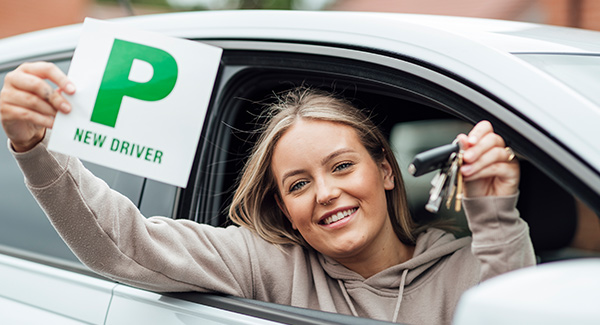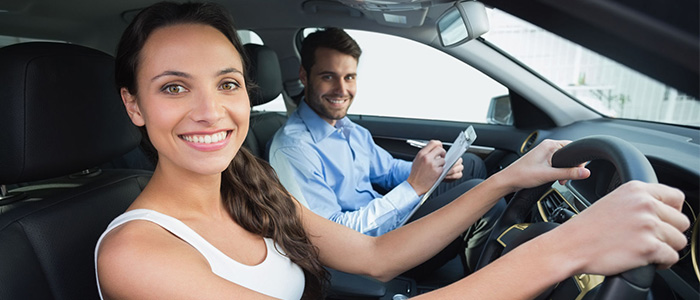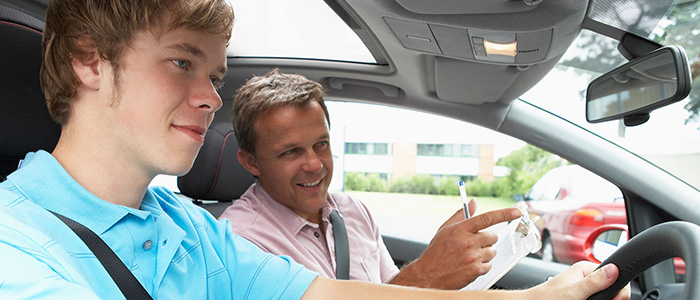Top driving test tips to help you pass like a pro
- Editorial Team
To pass your practical driving test requires dedication, determination and plenty of practice.
In this guide, we’ve put together our top driving test tips. First, we look at what happens during the practical driving test, so you know what to expect. Why learners fail, so you can practice improving your driving in these areas. We then provide several driving test tips to help you plan and prepare for your practical driving test, to give you a better chance of passing.
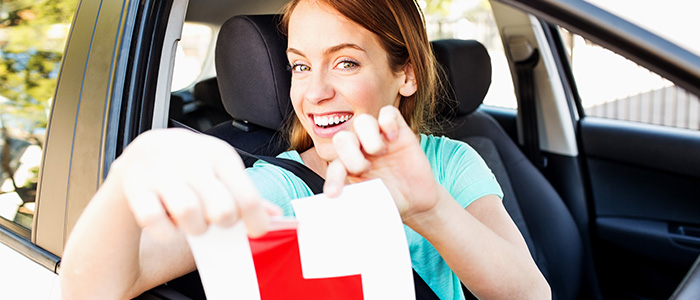
What happens during the practical driving test?
A good starting point is to know what’s involved in the practical driving test, which will help you plan and prepare for your big day.
- The practical driving test will last for around 40 minutes.
- There’s an eyesight check, which you need to pass before you can go out on the road.
- You’ll be asked a vehicle safety question at the start of your test before you start driving.
- You’ll drive in various road and traffic conditions, but not on motorways.
- Around 20 minutes of independent driving, where you can follow directions from a sat nav or traffic signs.
- There will be another vehicle safety question while you’re driving.
- Controlled stops, where you might be asked to carry out an emergency stop.
- One reversing manoeuvre where you’ll be asked to parallel park, park in a parking bay or reverse your vehicle and re-join the traffic.
Check your eyesight
- Before going out for your test, there’s an eyesight check, where you must be able to read a vehicle number plate, in good daylight, from 20 meters (20.5 meters for vehicle number plates made before 1st September 2001). If you need to wear glasses or contact lenses to do this, you must always wear them whilst driving.
- You have 3 attempts. If you fail to correctly read the number plate after the third attempt, you will fail your driving test. Also, the Driver and Vehicle Standards Agency will be informed and your driving licence revoked.
- You can reapply for a driving licence, but you’ll be asked to have an eyesight test with the DVSA. If you pass, you can then go on to take the driving test.
- If you’re learning to drive and are concerned that your eyesight isn’t up to the standards set, you should book an eye test before taking any more lessons.
Show me tell me questions
You’ll be asked 2 vehicle safety questions referred to as ‘show me, tell me’ questions during your driving test.
The examiner will ask you one:
- ‘tell me’ question (where you explain how you’d carry out a safety check) at the start of your test before you start driving.
- ‘show me’ question (where you show how you’d carry out a safety task) while you’re driving.
You’ll get one driving fault if you answer any of the questions incorrectly. You’ll fail your driving test if your driving is dangerous or potentially dangerous while you answer the ‘show me’ question.
For more information, see the DVSA guide to what happens during the driving test.
Reasons why learners fail their driving test
It helps to have some background and understanding as to why other learners fail their practical driving tests. This will allow you to spend more time practicing your driving skills in these areas, to help you avoid making those same mistakes.
Data from the DVSA reveals the specific areas where driving tests fail.
Junctions (turning right)
Take extra care at junctions, looking out for cyclists, motorcyclists and pedestrians.
- Use your mirrors so that you know the position and movement of traffic behind you.
- When it is safe to do so, signal to the right.
- Position just left of the middle of the road or in a space marked for traffic turning right.
- Brake gently and change to a suitable gear, so that you can approach the junction at a safe speed.
- Leave room for other vehicles to pass on the left, if possible.
Control (steering)
Drive with both hands on the wheel where possible, so that you’re always in full control of the vehicle.
Maintain a steady course and follow the contour of the kerb or roadside.
Turning too late, allowing the wheels to spin and driving with one hand on the wheel can cause danger to other road users and pedestrians.
Moving off (safely)
Before moving off you should:
- Use all mirrors to check the road is clear
- Look round to check the blind spots
- Signal if necessary, before moving out
- Look around for a final check
Move off when it safe to do so.
Positioning
You must maintain correct positioning at all times. Keep to the middle of any marked lanes if possible. You should avoid straddling markings and changing lanes unnecessarily.
Response to signs – road markings
When driving, you’ll come across a wide variety of road signs, signals and road markings. Your examiner will expect you to obey traffic signs giving orders and act accordingly towards other signs giving warnings, directions and other information. See traffic signs and signals for further information
Traffic lights
- Watch out for pedestrians, cyclists and other road users.
- Stop behind the white line when the traffic lights are on red and when it is safe to do so on amber.
- Don’t start creeping forwards when the red and amber lights are on.
- Proceed when the traffic lights change to green if it is safe to do.
- When a green arrow light is showing, you may move in the direction it indicates, providing it is safe to do so.
Reverse parking
Parallel parking is one of the four driving manoeuvres you will need to learn before your practical driving test.
When reverse parking, your examiner is looking for you to demonstrate your ability in the following areas:
- Keep control of the vehicle at all times through effective steering and clutch control.
- Effective observation by checking mirrors, blind spots and what’s going on around you throughout the manoeuvre.
- Complete the manoeuvre with a certain degree of accuracy, not finishing too far away from the kerb or the vehicle in front and avoiding touching the kerb or mounting the pavement.
How to parallel park
- Pull up in a suitable position to complete the driving manoeuvre.
- Before reversing backwards, make all round observations to check if there are any approaching vehicles or cyclists.
- Once everything is clear, proceed to move the car slowly backwards, making all round observations, as necessary.
- Whilst reversing, start steering to the left to bring the vehicle in at an angle towards the kerb.
- Once you establish a reference point, steer to the right to straighten the car, maintaining effective all-round observation.
- When the vehicle is close to the kerb and clear of the car in front, turn the steering wheel to the right, to bring the car parallel to the kerb. As you reverse slowly, maintain effective observation so you know what is going on around you.
- Complete the manoeuvre ensuring you are a suitable distance from the car you are parking behind and the kerb. Adjust if necessary.
Mirrors
Your examiner is looking for you to demonstrate good observation, including proper use of mirrors.
Before setting off, you must ensure your mirrors and seats are adjusted correctly.
All mirrors should be used effectively throughout the test.
- Use your mirrors frequently so that you always know what is behind and to each side of you.
- Use them in good time before you signal, change direction or speed
- When opening car doors.
Remember: Mirror > Signal > Manoeuvre
Blind spots
Look around to check blind spots (the areas you are unable to see in the mirrors). Failure to check these blind spots is one of the main reasons why learner drivers fail their driving test.
There are two main blind spots, on the left and on the right. However, depending on the size and shape of your vehicle, there may be other blind spots you need to look out for.
You should always check the blind spots before driving off, and when moving left or right, for example when changing lanes.
Check your blind spots more often in busier areas, where it’s more likely a pedestrian, motorbike or cyclist could disappear into your blind spots. Also, try and avoid getting in other driver’s blind spots, either move ahead or drop back, maintaining a safe distance.
To check your blinds spots, look over your shoulder, just past 90 degrees, turning your head, not your whole body.
Choosing the right driving instructor
Choosing the right driving instructor is an important part in preparing for your driving test. Learning to drive should be an enjoyable experience. A good instructor will teach you best driving practices and how to be safe on the road.
Recommended by others
The best driving instructors are often recommended by previous students. Look for recommendations online and from people you know, to help you choose the right instructor.
The DVSA also provide an online tool where you can find approved driving instructors in your area.
Local knowledge
A good driving instructor should have excellent knowledge of your local area and the likely driving test routes.
They can instruct you on roads and routes in and around the test centre, busy junctions and roundabouts, and where you’ll need to take extra care around pedestrians.
Reliability
Every second counts when it comes to learning to drive, so the last thing you need is an unreliable instructor that cancels lessons or turns up late, especially on the day of the test.
If you find yourself in this position, don’t be afraid to change instructors, find one that is punctual and committed to the lessons.
A teaching style that suits you
As a learner you’re going to make mistakes. A driving instructor should be with you every step of the way. Remaining calm and patient in stressful situations and encouraging where you feel comfortable and confident behind the wheel. They should know what makes you tick and how to get the best out of you.
Judgement
A good driving instructor will know when the right time is to put you forward for your test. Don’t feel pressured to take your test if you don’t feel ready and request more practice where necessary in the areas you feel you need to improve.
Humour
A good sense of humour in an instructor never goes amiss, especially when you’re nervous. A few jokes here and there can help lighten the mood and reduce your stress levels.
Good communication skills
Your driving instructor will need to be able to communicate driving instructions clearly and concisely, so that you know what you’re doing and how well you’re doing it.
When you make a mistake, they’ll know how to communicate effectively in a way that motivates you to improve without feeling disheartened.
Things to consider when choosing a driving instructor:
- How long have they been a driving instructor?
- Are they fully qualified?
- Do they have good knowledge of the local area and the driving test routes?
- Do they have good pass rates?
- How many lessons on average do their students have before they take their practical driving test?
- Are they reliable and on time?
- How flexible are they on lesson times and days?
- How long is each lesson?
- Will you get the same instructor and car for each lesson?
- Will you get on with the instructor?
- Does the instructor provide motorway lessons?
Familiarise yourself with the routes around the test centre
Although you won’t know the test route beforehand, it helps to familiarise yourself with the roads and routes in and around the test centre.
This will allow you to practice and familiarise yourself with busy roads, junctions, roundabouts, pedestrian crossings etc in the area, which you may experience during the test.
Your instructor should have an excellent knowledge of the driving test routes in your area and help you prepare for this.
Practice driving in different weather conditions
It helps to practice your driving skills in a variety of weather conditions, so you’ll be well prepared if the weather turns during the test and when it’s time to go it alone after you pass. You’ll also have the reassurance of your instructor by your side.
It is unlikely you will take your driving test in bad weather such as heavy rain, fog, snow or ice, so these conditions won’t be covered in this section.
Driving in wet weather
- Ensure that the windscreen wipers are working properly.
- Keep a sensible distance between you and the vehicle in front.
- If it is difficult to control the steering due to the wet conditions, ease off the accelerator and slow down gradually.
- Take extra care around pedestrians, cyclists, motorcyclists and horse riders.
Driving in Hot weather
- The vehicle that you’re practicing driving in should be well ventilated, so you can avoid drowsiness.
- If you are dazzled by bright light, slow down and if necessary, stop.
- Keep yourself hydrated.
Driving lessons in own car
You should always be looking for learning opportunities. The DVSA recommends an extra 22 hours of private practice on top of your normal lessons.
Getting in extra driving practice outside of lessons allows you to build on the skills you’ve learned from the instructor. It also gets you in the habit of driving regularly, so that it starts to become second nature.
Practicing in your own car, if you have one, is a great way to gain valuable experience behind the wheel. You’ll become familiar with the controls and the way the car feels to drive. You should also feel more confident going into your test having had the extra time to practice.
As a learner driver you must be insured to drive the vehicle and meet all the legal requirements.
Mock driving test
A mock driving test is a run through of the actual driving test. It allows you and your instructor to evaluate your driving, identify areas for improvement and gives you a taste of what to expect on the day of the test.
Although it’s not essential to take a mock test, it can improve your chances of passing the actual test.
Ideally, the mock test should:
- Take place in and around the test centre, to familiarise yourself with the routes.
- Be extended to include all driving manoeuvres and the emergency stop.
- Allow sufficient time to practice on areas for improvement before the actual test.
Passing the mock test is a step in the right direction and an encouraging sign that you’re ready for your practical test. However, it is important not to become complacent or over-confident, driving is unpredictable, and you never know what is going to happen during your practical driving test. If you fail your mock test, don’t take it to heart, stay positive and work on your weaknesses.
Driving test times
Choosing a suitable time to take your driving test is essential to give yourself the best chance of passing. Some studies suggest that there is a better chance of passing your test in the morning when you’re more alert.
Ideally, you want to book your driving test outside of the rush hour, where the roads are generally quieter, and drivers are in less of a hurry. Also try to avoid booking your test during the school run, where you’ll have to be extra careful around pedestrians, especially children.
Your instructor should have a good understanding of the driving test routes and be able to advise you on the best times to book your test.
Know the Highway Code
To pass your driving test, you must be able to show that you know the Highway Code and that this is demonstrated by the way you drive.
You can also take our Driving Test Challenge, which includes a selection of questions from the Highway Code that will help you prepare for your test.
What to eat and drink before your driving test
Your diet can play an important role in how you perform on the day of the driving test. When you eat right, the body gets the fuel it needs. However, get it wrong and you may end up taking your test feeling tired and sluggish.
Drink plenty of fluids
Dehydration causes tiredness and affects your levels of concentration and alertness.
To improve your focus behind the wheel, it is important to remain well hydrated. Water, juices and fresh fruit and vegetables all help to top up your body’s fluid levels. This is especially important if you’re taking your test in hot weather.
Avoid coffee and energy drinks
Although caffeine can increase your alertness, excess consumption can affect your concentration and make you feel nervous, agitated and restless. So, try to avoid coffee and energy drinks.
Fruit and Vegetables
Fruit is full of natural sugars that slowly release over a long period, keeping you alert and helping maintain your concentration levels whilst driving.
Fruit and veg are also high in water content which can keep you hydrated for longer.
Eat a Banana before your test
Described as a ‘driving test superfood’, bananas are full of vitamin B which help you manage stress. They are also rich in potassium and magnesium which give the brain energy and sharpens your focus. They also contain tryptophan which helps keep you positive.
Apples
Apples are a great source of fibre and are rich in carbohydrates, which help you feel full and energised for longer.
Carrots
Carrots are rich in beta carotene, which your body converts into Vitamin A, which helps with eyesight.
Fatty foods
Avoid fatty foods as they require more effort from your body to digest and can make you feel drowsy.
Heavy meals
Avoid eating a heavy lunch as this can make you feel drowsy and can reduce your reaction times on the roads.
Refined sugars
Excess sugar consumption from foods and drinks can make you feel anxious and affect your focus.
Mindset
Using visualisation techniques to help you pass your driving test
Visualisation can help you focus on the actions that will help you achieve your end goal. It is effective because it harnesses the power of your subconscious mind.
Spend some time visualising a positive experience, think about when you performed well during a lesson, such as when you successfully completed a challenging driving manoeuvre. This will increase your confidence and get you in a positive mindset.
Preparation
Boost your confidence and belief by reminding yourself how well you have prepared and how much practice you have put in to get to this point.
Overcoming setbacks
Remind yourself how you overcame previous setbacks, such as how you recovered after making a mistake on the road. This will prepare you well for future challenges and build up your mental resilience.
End goal
Think about your end goal and the reasons you’ve put in all the hard work and commitment. The only thing that stands between you and your freedom behind the wheel is convincing the examiner that you’re a safe and competent driver.
Get a good night’s sleep
Finally, get a good night’s sleep. You want to be at you best on the day of the test and sleeping well will improve your memory and concentration.
Regular exercise can relieve stress and anxiety and can help you sleep better.
Avoid alcohol, excessive caffeine consumption, eating a heavy meal or anything else which may disturb your sleep.
Dealing with driving test nerves
Feeling nervous or anxious before a driving test is perfectly normal and something many drivers experience.
In most cases, nerves can be kept under control. But in some situations, uncontrollable nerves may affect your concentration. This may cloud your judgement, which can lead to mistakes.
If you can control your nerves, you’ll make safer decisions and be well on your way to passing your test.
Advising you to stay calm is easier said than done, so here are a few tips which may help you relax and keep you calm on the day of the test.
Don’t put yourself under too much pressure
Don’t put yourself under too much pressure to pass your driving test. It’s not the end of the world if you fail. You’ll be able to retake the test when you feel more confident and have more experience.
Avoid planning road trips and weekends away with friends before you’ve passed. Also, try to limit the number of people you tell about taking your test. You don’t want to feel like you’re letting others down if you don’t pass.
Listen to music
If you get chance, try to listen to some music before your test to calm your nerves. Singing along to your favourite songs can help release stress and tension. You can even listen to music during your driving test at a low volume, although we advise against this.
Go through your playlist and choose songs that help you relax, feel happy or motivated. Avoid music with a fast tempo as this can make you rush and drive faster. Also, avoid music that gets you too pumped up, where you feel agitated.
Breathing exercises
Breathing exercises are easy to carry out and are the quickest way to manage your nerves and feel calm before your test.
Take a few deep breathes, expanding your stomach, as you breathe out, imagine you’re releasing any built-up tension and anxiety. Counting as you breathe can help to slow your breathing, calming your body and helping to clear your mind of any negative thoughts.
Squeeze a stress ball
Stress balls are filled with gel that you hold in the palm of your hand. Repeatedly squeezing the ball may help alleviate stress and tension before your test.
Take a walk
Studies suggest that going on a walk or doing 20 to 30 minutes of exercise before your test may improve your reaction times and sharpen your decision making.
Exercise also helps to clear the mind.
Pretend you’re on another lesson
If the nerves are getting the better of you, you could think of your test as another driving lesson. You could even ask your instructor to sit in on the test for reassurance.
Laughter
Laughter can help ease anxiety and tension, relieve stress, improve your mood and strengthen your resilience. So, before your test, crack a few jokes with friends or watch your favourite comedian to calm you down.
Dress comfortably
On the day of your practical driving test, wear something comfortable which you have practiced driving in before.
Avoid wearing tight or baggy clothes that may distract you whilst driving. Also, make sure you’re wearing comfortable footwear, suitable for driving in.
Have a driving lesson before your test
Have a lesson beforehand where possible. This will help calm the nerves, focus on areas you want to run through and get a feel for the roads and driving conditions.
Take the right documents to your practical driving test
Having put in hours of practice, the last thing you want is to fail the test because you didn’t provide the right documents.
Between April 2015 and March 2016, over 4,500 driving tests were cancelled because learners either didn’t provide the right documents or turned up in an unsuitable car.
What to take to your test
- Your UK driving licence
- Your theory test pass certificate
If you do not have a photocard licence, you will need to bring a valid passport and your paper licence.
You must provide the right documents, otherwise your driving test will be cancelled, and you’ll lose your fee.
See what to take to your test for further information.
Arrive for the driving test in plenty of time
Aim to arrive at the test centre around 15 minutes early, this will give you time to relax, focus and ask any last-minute questions.
If you make mistakes during your test
Making mistakes on the road is part of the learning experience. No matter how well prepared you are for your test, you never know what’s around the corner and you’re likely to make a few mistakes. Data from the DVSA reveals that in 2018/19 there were only 18922 tests passed with no faults.
Don’t dwell on your mistakes and most importantly don’t assume you’ve failed your test and give up. What you think might be a serious mistake, may only be a minor driving fault to the examiner. Take a deep breath, recover and concentrate on your driving.
Don’t get distracted by the examiner
Don’t be distracted by what the examiner is writing down. Just because the examiner is taking notes, doesn’t mean you have done something wrong. Stay focused and concentrate on the road.
The examiner might also chat to you to help you relax but remember to stay focused on your driving and not get distracted by the conversation.
Anticipate what’s ahead
Anticipation is about predicting what will and what might happen next. Driving is unpredictable, so always expect the unexpected. Effective observation, anticipation and planning are important characteristics for any driver.
You should always be scanning everything that is going on around you, anticipating other road users’ behaviour so that you can react in good time. For example, you may anticipate another car changing lanes and take appropriate action to avoid an accident.
Although anticipation improves with experience, one way that you can sharpen your brain’s processing skills is to commentate or describe what is going on around you whilst driving. This technique will help you process all the information around you, improve your reaction times to events and help you become a safer driver.
Final thoughts
The driving test tips outlined in this guide will help you plan and prepare for your practical driving test, but they won’t account for the unpredictable events you’ll face on the day. Be confident and remember it’s not a big deal if you don’t pass your test first time.
If you do fail your test, take on board the examiner’s advice and focus on the areas that need improving.
And If at first you don’t succeed, try, try again!
Share this article
Table of Contents
More posts
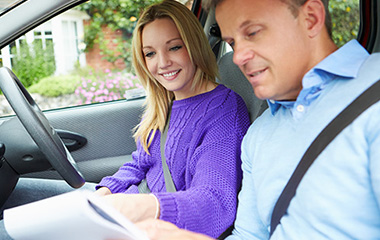
Can You Take Your Driving Test In Your Own Car | A Choice
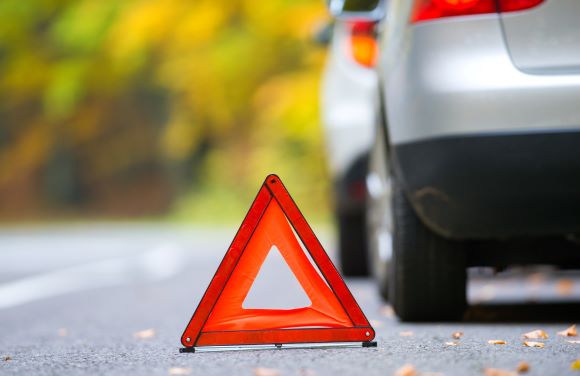
What To Do After A Car Accident | A Choice
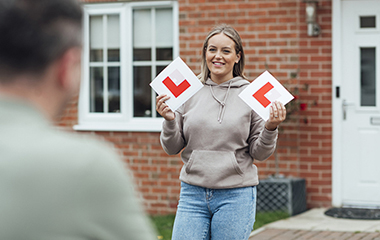
L Plates: What You Need To Know Before You Drive | A Choice
